So I’m back from Brighton, 5 hours of travelling each way and 2 hours of queuing was definitely worth it for front row seats and a prime view of a cat that really wanted to be a part of the show, but that’s not what you came here to read about, so let’s look again at the Magnet system.
One thing that is always good to have when emulating a system are high quality pictures of the board. Arcadehacker provided these along with the dumps and a whole bunch of other information which was helpful in getting things up and running. Let’s have a look at the basic hardware of the Magnet System (click on images for better resolution)
The system uses 5 main PCBs in the cage, so let’s start with a quick view of each layer
1st Layer (Sound)
The top layer is the sound board. This contains a Z80 CPU, 2 Z80CTC peripheral chips (timers / interrupt generators), 2 AY 8910 sound chips and an OKI M5205 ADPCM playback chip for a single channel of sampled sound.

2nd Layer (Master)
The 2nd PCB is the master board, this board drives everything else. It contains a Z80 CPU, the BIOS rom, 2 Z80 PIO peripheral chips (used for configurable I/O ports) and a SAB 2797B (floppy drive controller) The Floppy drive also connects to this PCB. There’s also a small sub-board on here covering some of the PCB, this contains a selection of RAM chips, I’ll look at it in more detail later.

3rd Layer (Plane PCB A)
The 3rd PCB is a ‘Plane’ board, it is used to generate a single background plane. Hardware-wise the main components are yet another Z80 CPU, and like the Master PCB, 2 Z80 PIO peripheral chips.

4th Layer (Plane PCB B)
The 4th PCB is another ‘Plane’ board, identical to the 3rd PCB. The only difference here is some jumper configuration.
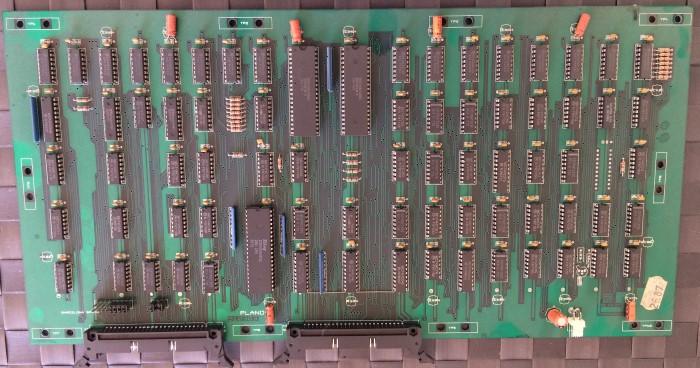
5th Layer (Sprite PCB)
The Sprite PCB sits at the bottom of the stack. Again we have a Z80, bringing our total Z80 count to 5 (one for each PCB) and this time we have 3 Z80 PIO chips (bringing out total count of those up to 9) There’s also a memory sub-board, which again contains RAM.
Holding it all together
Ribbon cables are the main way the boards are connected, as you can see from the following front/back/above views of the stack.


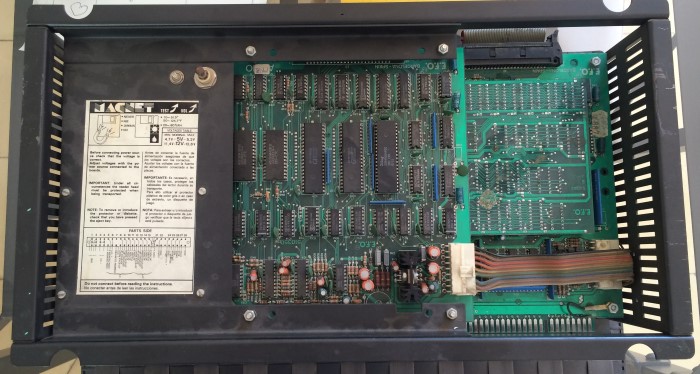
The Drive
The drive is a Mitsumi drive, there’s also an amusing warning on the panel above it telling you not to put Magnets near the Magnet system disks.


Master Board – More Detail
The Top board / Sound board in the initial pictures was obscured by the memory sub-board, so here are some cleaner pictures of both the board, the underside of the board, and the memory sub-board. It’s interesting to note that there is a wire mod on the back of the board.

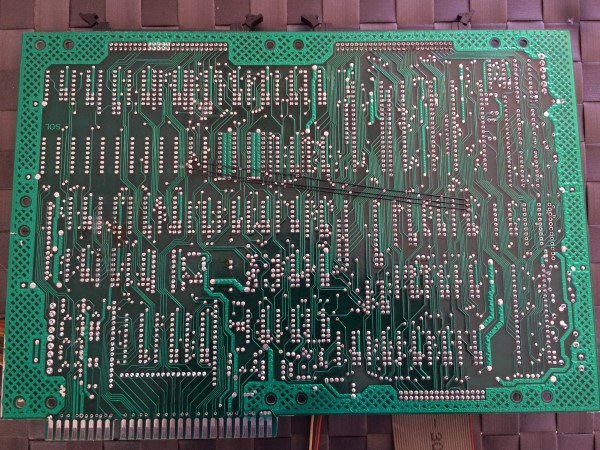
More interesting however is the memory sub-board which contains
1.5kbytes of memory in the form of 3x MOTOROLA MM2114N SRAM 4096 bit (4x1024bit each)
and
256kbytes of memory in the form of 8x SIEMENS HYB 41256-15 AA – 262,144 bit DRAM (32kbytes each)
These plug into the PCB where presumably memory chips would have originally been fitted, presumably offering a memory expansion over the initial base design.
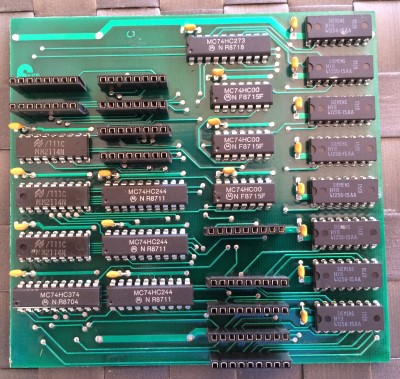
Sound / Plane Boards – Undersides
The Sound board and Plane boards have unremarkable undersides, there are no mods, and nothing was obscured by any memory sub-boards on the top views, so not much to show here.
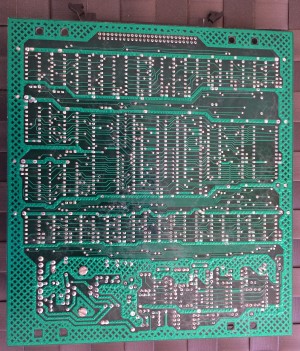
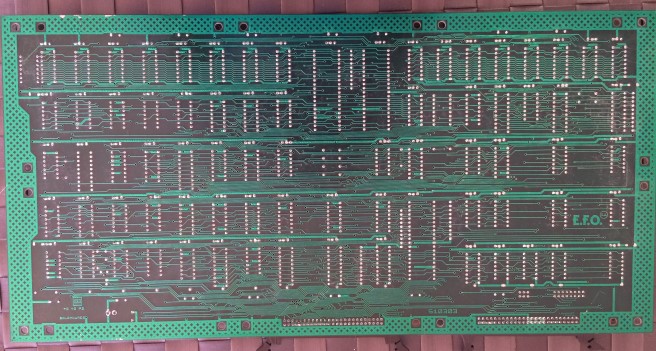
Sprite PCB – more detail
The Sprite PCB was another with a memory sub-board. Like the one on the main board this sub-board contains 256KB of RAM, and appears to plug into the sprite board where regular RAM chips would have been places. In this case it definitely looks like an afterthought because there are wires soldered directly from the board to pins on one of the PIO chips as well as another chip on the PCB. There is also some glue holding it in place, meaning it more difficult to remove, so no clean PCB shot for this one. There is a small mod to the back of the sprite board too.
Hardware Conclusion
5 Z80s, 9 Z80 PIO chips, 2 Z80 CTC chips, AY 8910s, an OKI M5205 and a floppy drive controlled by a SAB 2797B are the main features to note on this hardware. Also a fair amount of RAM, especially when you take all the extra memory on the plug-in boards into account. There are no known dedicated video chips on the PCB so everything is done with the logic you see.
Compared to the hardware the games that were ported run on the only thing that, on the surface, appears remotely close is Exzisus which had a 4x Z80 based setup, however in reality even the Exzisus hardware is very, very different to this, as I would find when I started to emulate it.
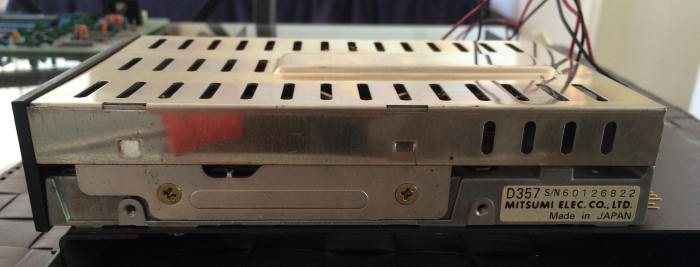
Nice beast, good look ;)
Great / master / superb programmers also ends finding another challenge to back to the load ….
Its a pleasure to see about your writings and researchs again, Haze…
It’s good to see you are back, Haze.
After looking at the company a bit, it seems that it tried to go into making professional Z80 computers with a similar design (tons of boards, tons of Z80s) before making the Magnet System, but the IBM PC managed to kill that off and they reworked elements the computer design into this thing.
yeah, it was a bit late to the market and underpowered, plus too large and expensive I guess.
the various RAM sub-boards suggest that this was based on an older design with the extra RAM hacked in, note how they wire straight from some pins of the PIO on the sprite board to the sub-board, it clearly wasn’t part of the original design but with arcade games you really don’t want constant disk accesses (it’s bad enough even with the extra ram, pausing to load between various parts of stages)
Hey wow cool stuff.
Just wanted to bring to your attention that your “best bud” Robbbert has another hack build of MameUI called Arcade64 that he’s peddling around in secret on his forum, telling people in an announcement not to mention it at Mameworld forums. Since he’s on the team and breaking licenses and stuff I figured you should know about it.
forum link: http://www.1emulation.com/forums/topic/35690-arcade-0179/
and the download link: http://hbmame.1emulation.com/geas/
I actually found out about this from emucr.com site and thought it was something new until I actually ran it and realized what it was.
1) MameUI Arcade64 is not breaking any license
2) Haze isn’t on the team, remember he left voluntarily. He won’t be able to do much if someone on MAME team misbehaves.
1) If it’s not violating anything then why is it hidden away out of sight on a forum thread that you can’t even read without being a member? Every other thread that does not pertain to Arcade64’s download link is open to the general public to read. That is mighty suspicious, wouldn’t you agree?
2) I never said Haze was on the team but he used to run the show back in the glory days, so I’d say he has a hell of a lot of say in all things Mame. Now piss off Robbbert and learn how to code a decent frontend, Arcade64 is a buggy piece of crap worse than MameUI.
1) Idunno, maybe he got fed up with the whinging? The kinda thing you’re doing now in 2), kiss ass of 1 dev, spank ass of other :P
What a Fucking Snitch :X
On a sperate note :) nice to see you back with some new writeups Haze gotta admit i’ve kinda missed em
over the last wee while
White Hat – Thanks Arcade is now cancelled for everyone.
Yo, I just wanna say it’s good to see ya back – your writeups have always been fascinating to read, especially since i haven’t found many other writers with a knack for describing arcade hardware quite the way you do!